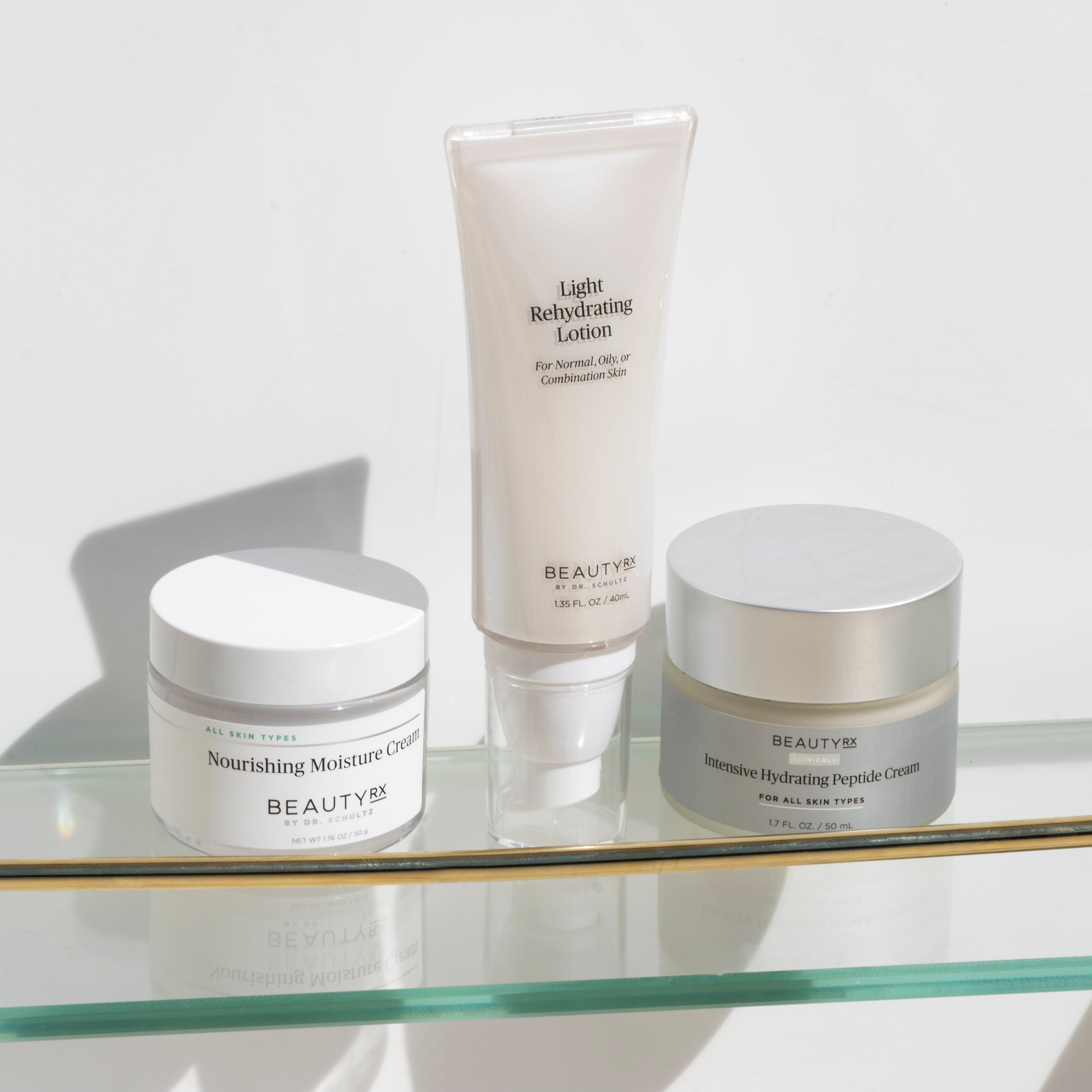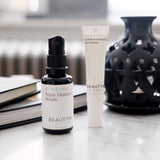
If you’re looking for ways to help get rid of dry skin, you’re not alone. So, let’s keep it simple: here are the basics for understanding and treating dry skin. With just a little bit of knowledge, you can choose the right products to restore hydration and balance in your skin—and Dr. Schultz is here to help. With over 35 years of experience as a leading, board-certified dermatologist in New York City, Dr. Schultz shares his expert advice on how to get rid of dry skin.
Why Is My Skin So Dry?
To put it simply, your skin is dry when it lacks water. This causes the skin to feel tight or appear flakey. It may also feel itchy or generally uncomfortable. There are many causes of dry skin—including a few surprising ones—but thankfully, you can take steps to combat these causes and avoid irritating your skin even further. Read on for the causes of dry skin, followed by Dr. Schultz’s best tips for treating dry skin.
What Causes Dry Skin
Winter weather is often a huge factor in causing dry, flaky, itchy skin. That’s because colder air is less likely to hold as much humidity as warmer air. Many people also take hot showers or baths during the winter, but unfortunately, this can dry out your skin because the hot water opens your pores and allows for more moisture loss. And although hot water might relieve some itchiness initially, it can also cause a reflex release of histamine in your skin—this will make you itch even more. A warm water bath is ideal, and it helps your skin absorb more moisture than a hot shower would. Watch as Dr. Schultz explains how to prevent and treat dry, itchy winter skin:
It’s also wise to pay attention to the kind of soap you’re using, since some soaps can strip too much oil from your skin. Dr. Schultz always advises against using bath oils because the oil actually coats your skin and prevents it from absorbing moisture.
Winter’s not the only season for dry skin. The summer sun might dry your skin out too. And on top of increased sun exposure, some people shower more frequently during warm weather due to sweating or physical activity—if so, be extra sure to avoid harsh soaps and cleansers, and take care not to overscrub your skin.
Dry skin in the eye area is another common, vexing issue. Your red, itchy, swollen eyelids might be caused by this surprising culprit: fresh nail polish. If you’re allergic to any of the chemicals in nail polish, you may feel irritation during the first 4–6 hours after the polish has been applied. After 6–8 hours of drying, the chemicals change and become harmless, but initially, it’s important to keep your fingers away from your eyes in order to avoid aggravating the itching.
Another common allergen you might not suspect is antibiotic ointment cream, like Neosporin. In the end, any allergen or irritant can cause eyelid contact dermatitis—dry, itchy, irritated skin around the eyelid—so you may have to use trial and error to identify the thing that’s bothering your eyes.
Extremely Dry Skin
If your skin is so irritated that it’s flaking, it’s normal to think your skin must be extremely dry. A common example is the scalp. Many people assume that a flakey, itchy scalp is caused by dryness. Here’s some news—your scalp probably isn’t dry. Dandruff is caused, ironically, by excess oil production, which leads to inflammation and shedding of the skin cells on the surface of your scalp. The flakes are large clumps of dead skin cells that fall off in thin, sheet-like pieces. Instead of trying to add moisture to your scalp, start shampooing regularly with your normal shampoo, or use a medicated dandruff shampoo. If these over-the-counter solutions don’t work within a few weeks, you may want to see a dermatologist.
If you have flaky skin near your nose or between and along the eyebrows, this too is usually dandruff, not dryness. It’s dandruff of the facial skin, and moisturizer doesn’t solve the issue. In fact, moisturizer can sometimes make the inflammation and flakiness worse. Instead, use an antifungal cream or a 1% cortisone cream.
There’s another area of the body that can become flaky and lead you to believe you’re dealing with extremely dry skin: the soles of your feet. Again, it’s not actually dry skin—it’s most likely athlete’s foot, a common chronic fungal infection. Moisturizer will only hide the flakes temporarily, so instead, use an antifungal cream at night coupled with a 10% glycolic gel in the morning to help dissolve the flakes.
How To Treat Dry Skin
If your true problem is dry skin, here’s your solution: moisturize, moisturize, moisturize! It’s important not only to replace the moisture that your skin loses, but also to minimize the amount of water your skin loses in the first place. If you have dry skin, reapply frequently. For very dry skin, rich moisturizers with some oil content can penetrate the skin deeply in order to heal it. However, for acne-prone areas of the body, use oil-free moisturizers that won’t clog your pores. The best products and best skincare routine for dry skin can be found at the end of this guide.
Again, bathe or shower with warm water instead of hot water. After bathing, pat yourself dry and immediately apply a rich moisturizer to help seal in any moisture that your skin picked up from your bath.
Use less soap on your body, especially during the winter. The less oil you strip from your skin, the more moisture your skin can retain, since the function of oil in your skin is not only to protect and lubricate it, but also to hold in any natural moisture your skin has. Try a milder soap that’s labeled for dry or sensitive skin. In the winter, you may even consider limiting the amount of soap you use on areas like your back, chest, arms, and legs. This is because these open areas of your skin don’t have as much bacteria accumulating and causing odors; what you’re rinsing off is mostly sweat, which is simply water and salt.

For bothersome itchiness, consider a moisturizer with menthol in it to cool and soothe the skin. Fight the urge to scratch your itchy skin since it will only cause it to itch more. Instead, use your fingers to apply pressure to the area and relieve the itchy sensation. If your skin is persistently dry and itchy, consider trying a non-sedating antihistamine. Avoid wearing wool as well if you have dry, itchy skin since the fibers can be very irritating.
Another useful tip for relieving dry skin is to use a cold water humidifier in your bedroom while you’re sleeping. Alternatively, you could place a pot of water on your free-standing radiator if you have one. The dry heat from the radiator causes the water in the pot to evaporate and add moisture to the air. Any humidifiers or water vessels should be cleaned daily in order to avoid bacterial buildup.
If you suffer from eyelid contact dermatitis, be sure not to rub your eyes when they’re dry, itchy, or swollen because this causes even more irritation. Instead, Dr. Schultz suggests that you treat the itchiness and dryness with lubricating eye drops or eye gel. Consider an oral antihistamine as well. Then, treat the irritation with a small amount of over-the-counter 1% hydrocortisone cream for 2–3 days. Finally, Dr. Schultz recommends that you consistently add moisture back to your eyelids with simple, non-irritating products like Vaseline. A dermatologist may be able to help with allergy or patch testing if these measures don’t resolve your issue.
Best Skin Care Routine For Dry Skin
To soothe and balance your dry skin, follow a basic skincare routine, which consists of a cleanser, toner, sunscreen, exfoliant, and antioxidant serum. Lastly, use a moisturizer like our Soothing Moisture Cream or Ultra Hydrating Eye Repair Cream. With dry skin, it’s imperative to replace the moisture that your skin has lost in order to help it stay hydrated.
Best Products For Dry Skin
Best Cleanser For Dry Skin
Our Balancing Cleanser is made with lavender and chamomile. It optimally balances your skin’s water and oil levels while washing away dirt, makeup, and excess oil. This product effectively cleanses your skin with overdrying it.
Best Toner For Dry Skin
Toner is essential to complete the cleansing process. The Clarifying Toner by BeautyRx is gentle and alcohol-free, which prevents it from overdrying your skin. It also contains humectants to retain moisture. Use this toner to remove residual cleanser, dirt, oil, and makeup.
Best Moisturizer For Dry Skin
The Soothing Moisture Cream by BeautyRx provides deep hydration and is the perfect solution for dry or very dry skin. In addition to softening your skin and diminishing the appearance of fine lines, this non-greasy moisturizer protects and soothes stressed skin, day or night. It contains powerful moisturizing agents like hyaluronic acid, shea butter, and willowherb as well as our proprietary antioxidant complex, Triantiox™️.
Best Exfoliator For Dry Skin
Even if you have dry skin, you can’t forget that exfoliation is key for removing dull, dead skin cells and revealing brighter, softer, more glowing skin. The BeautyRx Essential 8% Exfoliating Serum is a starter-strength glycolic serum that contains our proprietary exfoliating complex, Tetrafoliant™️. This serum reduces the appearance of enlarged pores, fades brown spots, brightens skin, and softens the appearance of fine lines.
Best Serum For Dry Skin
If you have dry skin that needs nourishing, softening, and hydrating, look no further. Our 10% Triple Vitamin C Serum packs an antioxidant punch and contains three of the most effective and stable forms of vitamin C. Its luxurious texture is a perfect match for dry skin. This fast-absorbing anti-aging serum reduces hyperpigmentation and dark spots, and it’s clinically proven to deliver smoother, brighter, softer skin.
Your At-Home Regimen
Once again, the best skin care routine for dry skin will include the basics, followed by moisturizer. In the morning, follow this routine:
And in the evening, follow this routine:
 BRX REWARDS
BRX REWARDS




















Leave a Comment